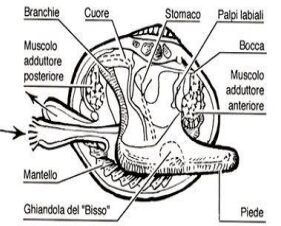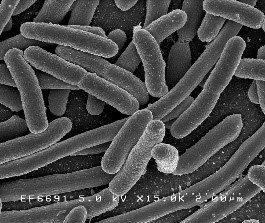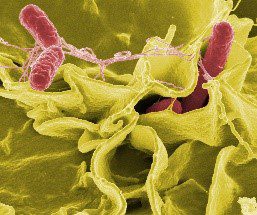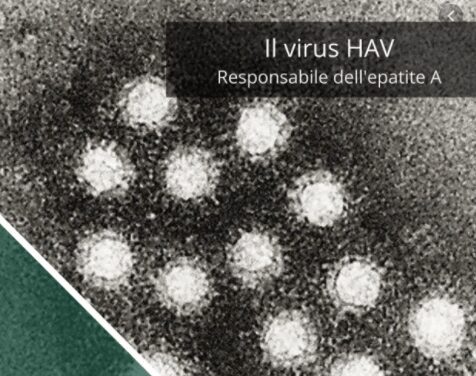Original article: Molluschi bivalvi – Vettori biologici di malattie dalla pesca al consumo, by Umberto Lazzaro
Features
Bivalve molluscs are widely distributed in the world as they are fish products that provide a high nutritional intake.
In particular, through their gills, they carry out a constant filtering activity, about 10 liters/h. They feed on plankton and organic particles present in the surrounding water: this peculiarity makes them biological accumulators capable of concentrating harmful agents (bacteria, viruses, toxins, heavy metals) inside them.

They are used as bioindicators; molluscs colonize coastal environments, often near urban areas, with high quantities of wastewater. Given the filtering peculiarity, these organisms represent a risk as they are responsible vectors of human diseases.
Pathogens: bacteria
These organisms represent risk factors, as their presence can cause environmental and human contamination. They contain bacteria, such as Escherichia coli, Salmonella, and Shigella spp. Among the most important pathogens are Vibrio (V. cholerae, V. vulnificus), Clostridium botulinum (non-proteolytic types B, E, F), Plesiomonas shigelloides, and Aeromonas spp.

A mollusc is considered fit for human consumption from a microbiological perspective when it does not exceed 230 E. coli/100 g and Salmonella spp. it is absent in 25 g.
In this regard, the technique provided by ISO/TS 16649-3: 2005 is an MPN (most probable number), that is, an indirect count of the microbial content carried out on liquid selective media.

Pathogenesis
Pathogenicity is evaluated in relation to the amount of germs taken in. The most considered pathogen is Salmonella spp.
Symptoms manifest between 16 and 20 hours after the consumption of molluscs and are characterized by: diarrhea, abdominal pain, and, sometimes, fever.
Diagnosis and therapy
A stool test evidences the pathogen. The most indicated therapy is represented by the restoration of fluids and electrolytes and has positive results in 4-5 days, furthermore, antibiotic treatments are administered to infants, old people and immunocompromised subjects.
Pathogens: viruses
The viruses associated with bivalves are about 120 species. They are considered enteric, result from fecal contamination, and causing gastroenteritis and hepatitis.
The viruses that cause gastroenteritis are:
- Calicivirus (Norovirus and Sapovirus);
- Rotavirus;
- Adenovirus.

The incubation period ranges from a minimum of 12 to a maximum of 60 hours. Symptoms include malaise, abdominal pain, diarrhea, and vomiting. The course is relatively rapid, 24-48 hours.
Among hepatitis viruses transmitted by the fecal-oral route we find:
Hepatitis A (HAV);
Hepatitis E (HEV).

Hepatitis A has an incubation period of 2 to 7 weeks. The most common symptoms are fever, pain, anorexia, nausea, and abdominal pain. The course of the disease varies from 1-2 weeks to a few months.
Prevention measures
The main preventive measure is associated with the proper cooking of the food. After cooking,the molluscs must be opened to increase the concentration of heat in organic areas subject to bioaccumulation. The second is correct management and analysis of wastewater systems near mussel colonies and related controls during the marketing phase.
Umberto Lazzaro
Sources
- https://it.wikipedia.org/wiki/Mytilus_galloprovincialis
- Regoli F., Orlando E. (1993) Mytilus galloprovincialis as bioindicator of lead pollution: biological variables and cellular responses. Science of Total Environment Supplement, 2, 1283-1292
- Galari, Danilo (2018) Ricerca di Salmonella spp. ed Escherichia coli in molluschi bivalvi vivi.
- Palese A.& Palese L. (1991) Il controllo sanitario e qualitativo dei prodotti alimentari della pesca. Piccin, Padova. Sebastio C. (1980) Igiene e controllo sanitario dei prodotti della pesca. Casa Editrice Impremare, Taranto
- Molluschi bivalvi vivi e echinodermi, tunicati e gasteropodi marini vivi di Patrizia Cattaneo e Cristian Bernardi
- Lowe S. J., M. Browne and S. Boudjelas (2000) 100 of the World’s Worst Invasive Alien Species IUCN/SSC Invasive Species Specialist Group (ISSG), Auckland, New Zealand
- Koopmans, M., & Duizer, E. (2004). Foodborne viruses: An emerging problem. International Journal of Food Microbiology, 90, 23–41.
- Aprea G. 2011. Norovirus and Epatitis A Virus: Foodborne Pathogens Responsible of Human Viral Gastroenteritis. 2nd Annual World Congress of Virus and Infection (WCVI), July 30 – August 1, Beijing, China
- Ministero della Salute – Direzione Generale per la sicurezza degli alimenti e della nutrizione, Ufficio VIII Bibliografia ex VI. Raccomandazione Prot. DGSAN/VII (ex VI) 3734 del 20.04.2007.
- Escherichia coli, Salmonella spp., Virus dell’Epatite A e Norovirus in Molluschi Bivalvi nel 2011-12 in Sud Italia di: Giovanna Fusco, Giuseppe Aprea, Giorgio Galiero, Achille Guarino, Maurizio Viscardi
- I VIRUS NEI MOLLUSCHI BIVALVI: M N Losio, P Boni Istituto Zooprofilattico Sperimentale della Lombardia e dell’Emilia Romagna Brescia
- Croci L, Suffredini E. Rischio microbiologico associato al consumo di prodotti ittici. Ann Ist Super Sanità 2003;39(1):35-45
- Tortorello ML. Indicator organism for safety and quality-uses and methods for detection: Minireview. J AOAC Intern 2003;86(6):1208-17.